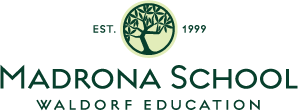What is 1st grade like at a Waldorf school? The 1st grade year at Madrona School marks the beginning of an eight year school journey. The theme of the year is formation: where the class teacher builds relationships between and amongst the children and parents to grow the all important class community; where the children begin to form the habits that will mark their student lives; where the building blocks of writing, reading and math are planted and nurtured. The class teacher is traditionally at the start of their journey too, looping up through the grades, beginning relationships that will grow and change as the children move through many developmental stages.
The year begins with the Rose Ceremony. The whole of the grade school gathers together to welcome in the new 1st grade class. While everyone looks on, our newest students literally bridge from early childhood to grade school, bringing a flower with them to form a bouquet the represents their new class community. As they walk across a wooden bridge, their new teacher is there to shake their hand and welcome them to 1st grade. We also acknowledge the breadth of the journey they undertake with our 8th grade class, whom, while at the opposite end of their school journey, do remember what it was like to be in 1st grade and are there with welcoming roses and a promise to work with the newest class throughout the year. Once the brief ceremony concludes, the class returns to their classroom with their teacher for their first lesson -- a story, and some form drawing.
There is so much to learn in first grade. It is truly hard work to sit at a desk, to stand in line, to raise your hand before you speak, to care for your own self, and learn to see, hear and care for your classmates. And then there is the academic work, and in first grade we focus on writing, reading and math. Letters and simple words and sentences step children towards independent reading; exploring the qualities of numbers and the four basic processes introduce mathematics; science comes through observing nature on neighborhood walks and in seasonal song. There is time to work at your own pace, to practice careful book work, to learn to listen well.
One example of a lesson is the first form drawing lesson mentioned above, a seemingly simple exploration of straight lines and curved lines. Students are encouraged to carefully draw both and begin to observe them in the classroom -- the world we can see is, of course, made up of straight and curved lines, an idea that is foundational to art, to writing, to honing our all important observation skills. This first lesson illustrates how we encourage each student to observe the world around them, to mindfully approach their work, and the deceptive simplicity of truly seeing what underpins how we communicate.
Story is an important element of how we deliver material, and we engage a young student's imagination to teach abstract concepts such as letter sounds, and the qualities of numbers. Stories help make these ideas -- the sound a 'p' makes or what is '1', for example -- concrete and visible and memorable. Movement cements ideas too, and you will often see the first graders moving through a counting game or draped on the floor, spelling out words with their bodies. In addition to self-management and academics, the students have handwork, beeswax, painting, music, games and world language classes. The first grade curriculum is varied and interesting and so much fun, and it is no wonder that the children are tired at the end of their day!
Planning work is underway for next year's first grade class. Please help us spread the word about Madrona School's elementary education and the journey these young students begin together. Madrona School first graders begin a journey that is joyful, artistic, and emotionally intelligent, where each of our students prepares for life and learns to rub along together. What could be better?
















